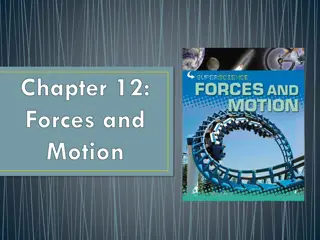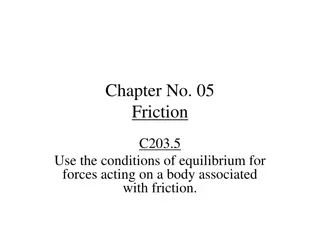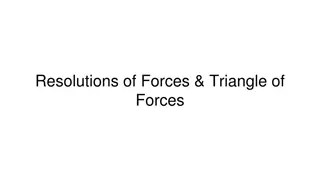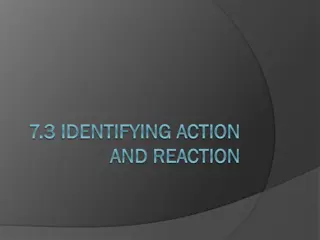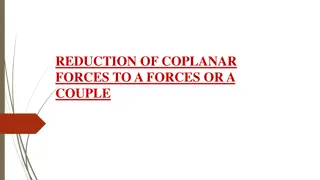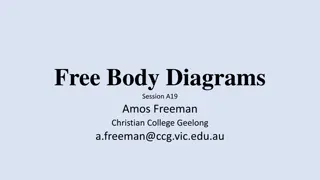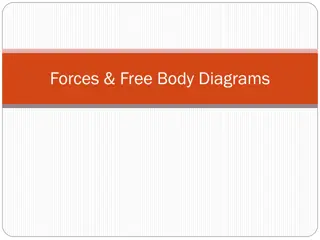Understanding Forces in Physics
Explore the concept of forces in physics, including definitions, measurement units, combining forces, and their effects on objects' motion. Learn about balanced and unbalanced forces, net force, force pairs, directions, magnitude, and how to combine forces at right angles. Develop a solid understanding of the fundamental principles that govern the motion of objects in the physical world.
Download Presentation

Please find below an Image/Link to download the presentation.
The content on the website is provided AS IS for your information and personal use only. It may not be sold, licensed, or shared on other websites without obtaining consent from the author. Download presentation by click this link. If you encounter any issues during the download, it is possible that the publisher has removed the file from their server.
E N D
Presentation Transcript
May the Force Be With You!
Learning Objectives I can recognize forces that affect the motion of matter. I can compare balanced and unbalanced forces. I can determine the net force on an object.
What is a force? A force is a push or pull that causes an object to move, stop, or change direction In physics a force is anything that makes an object accelerate If an object is stationary, it won t start moving without a force.
Force Forces come in pairs Forces have a magnitude and a direction Force is a vector quantity Magnitude: 5N Direction: north (up) 5N, north (up)
Force Measurement and Units SI unit for force is the Newton A Newton is a force that causes a 1kg mass to accelerate at a rate of 1m/s/s. 1 N (Newton) = 1 kg * m/s/s We use a spring scale to measure force.
Combining Forces Net Force The overall force acting on an object after all forces are combined. - Forces in the same direction we add them. Net Force = 10N 10N 10N = + - Forces in opposite directions you subtract them. 7N Net Force = 3N 10N - =
Forces in the Same Direction When forces are applied in the same direction, they are added to determine the size of the net force.
Forces in Different Directions When two forces act in opposite directions, you subtract the smaller force from the larger force to determine the net force. The net force will be in the same direction as the larger force.
Combining Forces at Right Angles Use the Pythagorean Theorem. - a2 + b2 = c2. - Can only use if adding only 2 vectors that make a right angle. c b a
Combining Forces at Right Angles Use the Pythagorean Theorem - a2 + b2 = c2. - ex. What is the resultant force if you have a force 3N South and another force 4N West and show the diagram. a2 + b2 = c2 c2 = 42 + 32 c2 = 16 + 9 c2 = 25 c2 = 25 c = 5 N SW 4N West 3N South 5N South West
Balanced and Unbalanced Forces Forces occur in pairs and they can be either balanced or unbalanced
Balanced Forces: The forces in each direction are equal . If more than one force is present, it does not have to cause an acceleration on an object. If another force balances the first out, there will be no acceleration at all. Think: If both guys (who weight the same) pull on a rope in opposite directions, with an equal amount of force, how much will they move?
Balanced Forces Balanced forces do not cause a change in motion They are equal in size and opposite in direction The net force is 0
Example: Ground pushes up Gravity pulls down Gravity pulls down on you The ground pushes back up If these football players push on each other equally as hard, will either one move? THIS KEEPS YOU WHERE YOU ARE!
More Balanced Forces 5 N 5 N 5 N 5 N Forces may cancel each other and produce no movement =No Acceleration!
Unbalanced Forces If the multiple forces acting at one time are not balanced out (equal), then acceleration can/will occur on the object! Kicking the ball causes it to move quickly in a different direction If one side of the scale has more mass, then gravity will accelerate it down!
Unbalanced Forces An unbalanced force always causes a change in motion The net force is greater than 0 When unbalanced forces act in opposite directions you can find the net force Net force Magnitude The difference between the two forces Direction Direction of the largest force
Unbalanced Forces 3 N, right 6 N, left = 3N, left
Unbalanced Forces 4 N, left 10 N, right = 6N, right
Unbalanced Forces 5 N, right + 10 N, right =15N, right
Multiple forces can combine to move an object that has too much inertia for one Unbalanced Forces Cause Acceleration force alone. The forces add together ! Adding Forces: 5 N What you just saw was like two people pushing on the same box. Random Object 5 N Notice that all the new forces are pointed in the same direction, and they add together! So, instead of only 5N of force pushing the object; now there are 10 N of force pushing! All by himself, one person might not be able to push a car. But with extra friends pushing, it becomes much easier! The forces add together.
Unbalanced Forces Cause Acceleration occur. The forces will subtract from each other! If forces are not equal and are acting in opposite directions, a negative acceleration can/will Subtracting Forces: 5 N 5 N Object 5 N Notice that the forces are unequal and pointed in the opposite direction. So they are unbalanced and work against each other or one partially cancels the other. The end result is that the forces on the left are slowed down by the single force on the right
Review Balanced Forces Balanced Push i.e. Pushing a Car No Acceleration or change in motion Net Force = 0 10N 10N Balanced Pull i.e. Tug-o-war No Acceleration or change in motion Net Force = 0 10N 10N
Review Un-Balanced Forces Add Together Un-Balanced Same Direction Faster 10N 10N Net Force > 0 Acceleration Subtract from each other Un-Balanced Opposite Direction Slower Acceleration 10N 10N Net Force > 0 10N


